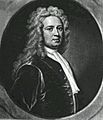William Stukeley facts for kids
Quick facts for kids
William Stukeley
FRS FSA
|
|
|---|---|
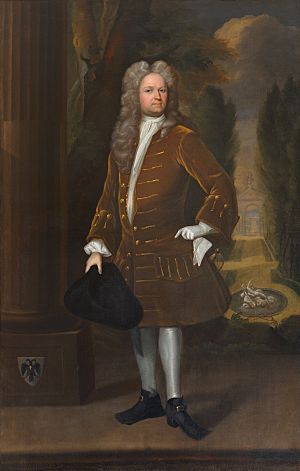
Portrait attributed to Richard Collins
|
|
| Born | 7 November 1687 |
| Died | 3 March 1765 (aged 77) |
| Alma mater | Corpus Christi College, Cambridge |
| Scientific career | |
| Fields | Archaeology |
William Stukeley (born November 7, 1687 – died March 3, 1765) was an English doctor, church leader, and a very important early archaeologist. He is famous for being one of the first people to study ancient sites like Stonehenge and Avebury in England. He wrote more than twenty books about old places and other topics during his life.
Contents
William Stukeley: Explorer of Ancient Britain
William Stukeley was born in Holbeach, Lincolnshire. His father was a lawyer. William first worked in his father's law business. Later, he went to Cambridge University. In 1709, he started studying medicine at St Thomas' Hospital in London. After that, he worked as a doctor in Boston, Lincolnshire.
Becoming a Doctor and Explorer
From 1710 to 1725, Stukeley went on yearly trips across the countryside. He was looking for old monuments and other interesting features. He wrote down what he saw and published many stories about his travels.
In 1717, he moved back to London. There, he became part of the groups interested in ancient history. In 1718, he was chosen as a member of the Royal Society. He also became the first secretary of the Society of Antiquaries of London. In 1721, he joined the Freemasons. In 1722, he helped start the Society of Roman Knights. This group studied Roman Britain.
Discovering Stonehenge and Avebury
In the early 1720s, Stukeley became very interested in Stonehenge and Avebury. These are two huge stone circles in Wiltshire, England. He visited them many times. He did fieldwork to measure their size and layout. He even saw local people breaking up the large stones. This made him want to record the sites in detail before they were damaged further. His drawings and notes are very helpful for archaeologists today.
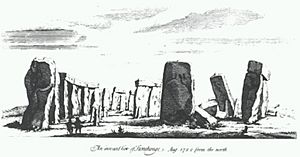
A New Path: Church and Ancient Beliefs
In 1726, Stukeley moved to Grantham, Lincolnshire, and got married. In 1729, he became a priest in the Church of England. He was appointed vicar of All Saints' Church in Stamford. He was friends with the Archbishop of Canterbury, William Wake. The Archbishop encouraged him to use his studies of ancient history to support Christian beliefs.
Stukeley started to believe that Britain's ancient druids followed a religion that was similar to early Christianity. He called this "Patriarchal Christianity." He thought the druids were monotheistic, meaning they believed in one God. He also believed the stone circles were built by the druids. He thought they were shaped like serpents and symbolized the Trinity.
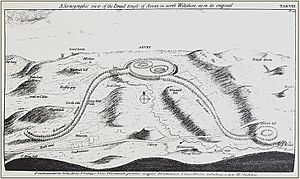
Later Years and Legacy
In 1747, Stukeley moved back to London. He became the rector of St George the Martyr, Holborn. In his later life, he wrote one of the first biographies of the famous scientist Sir Isaac Newton. He is known for sharing the story of the falling apple that supposedly inspired Newton's ideas about gravity.
Stukeley's ideas were important to many people interested in ancient history during the 1700s and early 1800s. Artists like William Blake were also influenced by him. However, by the late 1800s, many of his ideas were no longer accepted by archaeologists.
He was involved in setting up the British Museum. He also helped run the Foundling Hospital, where he met the artist William Hogarth. Stukeley was very concerned about the destruction of ancient monuments. He tried to stop people from taking stones from Hadrian's Wall.
William Stukeley died in 1765 at the age of 77. He was buried in the churchyard of St Mary Magdalene's Church, East Ham.
Stukeley's Big Ideas
Stukeley had a strong interest in ancient religions and how they connected to nature. He believed that God was present everywhere and in everything. He thought that music and numbers showed a divine order. He also believed there were hidden connections between different parts of the natural world.
Many of Stukeley's ideas came from older writings. He believed the Bible was literally true, including the story of creation and Noah's flood. When he first studied Avebury and Stonehenge, he didn't think they were built by druids. At that time, many people thought the Romans or even Danish invaders built them. But he later adopted the idea from John Aubrey that the druids built these monuments.
Stukeley thought the druids were like an "oriental colony" of Phoenicians. He believed they settled in Britain after Noah's flood. He said the druids followed "Abraham's religion" and believed in one God, even without direct revelation. He also thought their religion was so much like Christianity that the only difference was they believed in a Messiah who was yet to come, while Christians believe he has already come.
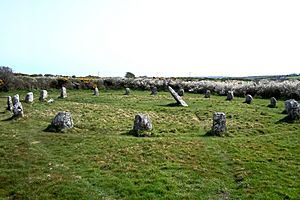
He even thought that Hercules was a leader of the Phoenician druids. Stukeley believed Hercules came to western Britain and built the Boscawen-Un stone circle in Cornwall. He also believed that because Britain was isolated, the druids there kept the ancient monotheistic religion alive. He thought Britain was a special nation chosen by God.
How He Studied the Past
Stukeley emphasized measuring and recording historical sites. He encouraged others to do the same. He also dug in and around archaeological sites, calling it "like an anatomical dissection." He understood that different layers of soil meant different time periods at a site. This idea is called stratigraphy.
From the 1720s, he believed that the ancient site at Avebury was shaped like a snake with a head and tail. By 1724, he thought the snake symbolized Christ. He used scientific ideas of his time to estimate that Stonehenge was built in 460 BC and Avebury in 1860 BC.
His Personality
People described Stukeley as a friendly person who enjoyed talking and being praised. He was seen as having a "charming and pleasant oddness" and a cheerful nature. However, in his later years, he became more stubborn about his opinions.
Stukeley loved structure and design, which showed in his interest in old buildings and ancient sites. He enjoyed gardening and liked both city and country life. He was also very fond of his pets.
He sometimes used the name "Chyndonax," which was the name of an ancient priest. His friends in the Society of Roman Knights often called him "the Druid." This showed his personal connection to his studies of the druids.
By 1740, he started drawing the perfectly circular stone circles at Avebury as ovals. He did this so they would better fit his idea of a serpent's head, which he believed they symbolized.
Images for kids
-
The Rollright Stones in Oxfordshire, which Stukeley visited.
-
Stukeley's 1722 drawing of Kit's Coty House in Kent.
-
A 1721 view of Gloucester Blackfriars by Stukeley.
See also
 In Spanish: William Stukeley para niños
In Spanish: William Stukeley para niños





